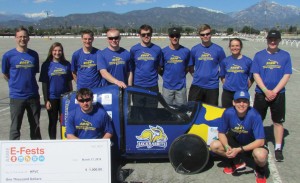Once again, South Dakota State University engineering students proved themselves No. 1 at building and racing a human-powered vehicle.

Overall winners of the Human Powered Vehicle contest in Pomona, California, March 15-17, pose with Quack Jack, the pedal-powered vehicle they designed, built and raced. The South Dakota State University engineering students are, back row, from left, adviser Gregory Michna, Sara Broad, Evan Fick, Nicholas LaFave, Alexander Gray, Ray Munsterman, Evan Tebay, Anna Fasen and Cole Brown. In front, Lane Prather, left, and Joshua Goehring.
Detouring through Texas to avoid a major blizzard on the High Plains, Associate Professor Gregory Michna and 10 students in the Department of Mechanical Engineering drove a van and a car 1,900 miles to Los Angeles for the March 15-17 E-Fest competition.
By the time the crew headed home March 17, it was hauling back trophies for design, men’s and women’s sprints, endurance and best overall entry.
Named Quack Jack because the vehicle was equipped with a car horn that quacked like a duck, the South Dakota State entry was powered by pedals but designed much like a small race car. The body is composed of carbon fiber composite with a shrinkwrap windshield and windows. It is aerodynamically sound and weighs only 65 pounds.
The vehicle builds on the success of the school’s 2018 entry, which won regional competitions in Los Angeles and at Penn State.
Michna said steering components were redesigned with carbon fiber rather than aluminum to make the vehicle lighter. Also, the roll cage and fairing were redesigned so a parcel could be placed inside the vehicle instead of hanging the parcel on the outside of the vehicle.
Aided by athletic engineers
In the endurance event, a 2 ½-hour race, contestants try to complete as many 1.5-kilometer laps as possible. They have to negotiate speed bumps, rumble strips, slalom turns, a quick turn, the parcel pickup and drop off and, new this year, a hill climb.
The South Dakota State entry completed 34 laps, two laps ahead of second place.
SDSU used five drivers. Senior Alex Gray, Barrington, New Hampshire, is an endurance bike rider and served as the team captain. He was joined by four members of the Jackrabbits track team: distance runners Evan Fick, Garretson, and Ray Munsterman, Brookings; and middle distance runners Joshua Goehring, Sioux Falls, and Anna Fasen, Big Lake, Minnesota, all juniors.
The five nondriving participants were freshman Sara Broad, Lincoln, Nebraska; sophomore Evan Tebay, Huron; junior Lane Prather, Ida Grove, Iowa; senior and head mechanic Nicholas LaFave, Mission Hill; and junior Cole Brown, Sioux Falls.
Fasen repeats as women’s champ
Building Quack Jack took an estimated 1,000 hours and included four students who didn’t make the cross-country trip. The frame and other parts were assembled in a lab in the Architecture, Mathematics and Engineering Building with the work divvied up among the future engineers.
The first day of the event, sponsored by the American Society of Mechanical Engineers, was for design judging and safety inspection. SDSU placed third in design.
The 280-meter sprint races were on day two. Both the men and women had the second-fastest qualifying times. Teams then faced off in a double-elimination bracket. Fasen was undefeated in repeating as the women’s winner. The men’s entry had three racers—Fick, Munsterman and Goehring—and had to come back through the consolation bracket, but prevailed on the legs of Goehring to twice beat Missouri Science and Technology.
Michna expected a bigger challenge when Quack Jack competed in the E-Fest North, the competition’s other North American challenge, April 5-7 in East Lansing, Michigan. Out of 50 teams, SDSU finished third overall after placing second in endurance, third in design and women’s speed, and fourth in men’s speed.






